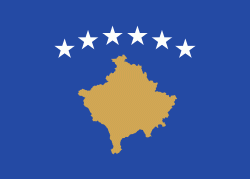District of Mitrovica (Mitrovica District)
Mitrovica District (Rajoni i Mitrovicës, Косовскомитровачки округ, Kosovskomitrovački okrug) is one of the unified seven districts of Kosovo. Its administrative center and the largest city is Mitrovica. The district borders on the District of Peja to the south-west, the District of Pristina to the south-east and east, and the Republic of Serbia to the north and northwest.
The first human habitations here can be traced back to the Prehistoric period. Some Neolithic sites have been discovered in the Mitrovica District, such as in Runik, Žitkovac-Karagaç, Vallaç and Fafos. This region was populated by Dardanians, an Illyrian tribe that lived in the territory of modern-day Kosovo. By the end of the 1st century BC, the Romans invaded the region. At the time, one of the most important centres in the region was Municipium Dardanorum, located in Sočanica, Leposavić. Archeological sites from the Roman period were also found in the territory of Vučitrn (Vicianum), for example the ruins in Pestova and the Rashan Fortress. Following Roman downfall, the Mitrovica was occupied by Byzantium. During the Justinian I period (527-565AD), the Old Fortress in Vučittn was built, which remains the city center today. By the end of the 9th century, the region of Mitrovica became part of the Bulgarian state of Samuel. The area was conquered by the Nemanjić dynasty in 1185. During Serbian rule, the region and Kosovo in general became a political and spiritual centre of the kingdom. The Ottomans later conquered the region in the 14th century and stayed until the 17th century. During this Ottoman period, Islam spread and many mosques, Turkish baths, madrasah, bridges and Ottoman houses were built. The cities of Vučitrn, Mitrovica and Zvečan became some of the largest cities in the region, and some of the most important in the Ottoman Empire. In 1912, after the Ottoman capitulation, Serbia acquired the territory of Kosovo. In the first World War, the region was part of the Austro-Hungarian Empire (1915–18), then part of the Kingdom of Serbs, Croats and Slovenes. In World War II, Germany conquered most of the territory in the region, while other areas fell to the Italians. After World War II, the economy grew in the region under Yugoslavia.
The first human habitations here can be traced back to the Prehistoric period. Some Neolithic sites have been discovered in the Mitrovica District, such as in Runik, Žitkovac-Karagaç, Vallaç and Fafos. This region was populated by Dardanians, an Illyrian tribe that lived in the territory of modern-day Kosovo. By the end of the 1st century BC, the Romans invaded the region. At the time, one of the most important centres in the region was Municipium Dardanorum, located in Sočanica, Leposavić. Archeological sites from the Roman period were also found in the territory of Vučitrn (Vicianum), for example the ruins in Pestova and the Rashan Fortress. Following Roman downfall, the Mitrovica was occupied by Byzantium. During the Justinian I period (527-565AD), the Old Fortress in Vučittn was built, which remains the city center today. By the end of the 9th century, the region of Mitrovica became part of the Bulgarian state of Samuel. The area was conquered by the Nemanjić dynasty in 1185. During Serbian rule, the region and Kosovo in general became a political and spiritual centre of the kingdom. The Ottomans later conquered the region in the 14th century and stayed until the 17th century. During this Ottoman period, Islam spread and many mosques, Turkish baths, madrasah, bridges and Ottoman houses were built. The cities of Vučitrn, Mitrovica and Zvečan became some of the largest cities in the region, and some of the most important in the Ottoman Empire. In 1912, after the Ottoman capitulation, Serbia acquired the territory of Kosovo. In the first World War, the region was part of the Austro-Hungarian Empire (1915–18), then part of the Kingdom of Serbs, Croats and Slovenes. In World War II, Germany conquered most of the territory in the region, while other areas fell to the Italians. After World War II, the economy grew in the region under Yugoslavia.
Map - District of Mitrovica (Mitrovica District)
Map
Country - Kosovo
 |
 |
In classical antiquity, the central tribe which emerged in the territory of Kosovo were the Dardani, who formed an independent polity known as the Kingdom of Dardania in the 4th century BC. It was annexed by the Roman Empire by the 1st century BC, and for the next millennium, the territory remained part of the Byzantine Empire, whose rule was eroded by Slavic invasions beginning in the 6th–7th century AD. In the centuries thereafter, control of the area alternated between the Byzantines and the First Bulgarian Empire. By the 13th century, Kosovo became the core of the Serbian medieval state, and has also been the seat of the Serbian Orthodox Church from the 14th century, when its status was upgraded to a patriarchate. Ottoman expansion in the Balkans in the late 14th and 15th century led to the decline and fall of the Serbian Empire; the Battle of Kosovo of 1389 is considered to be one of the defining moments in Serbian medieval history. The Ottomans fully conquered the region after the Second Battle of Kosovo. The Ottoman Empire ruled the area for almost five centuries until 1912.
Currency / Language
| ISO | Language |
|---|---|
| SQ | Albanian language |
| SR | Serbian language |




















